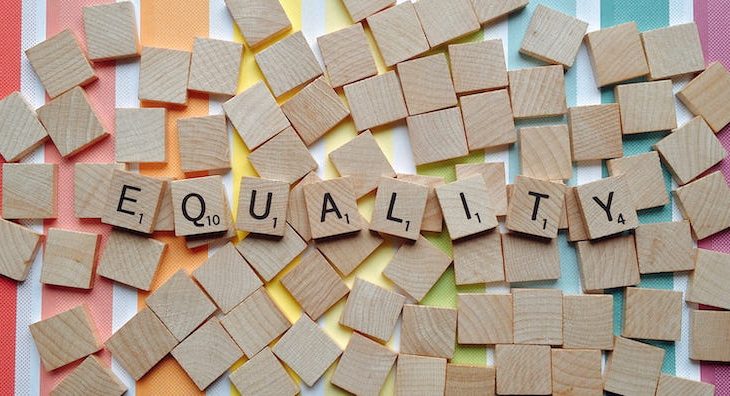Maria Giammarco, Science and Society editor
International Women’s Day is a day of optimism and empowerment, marked by the celebration of women’s achievements and acknowledgement of progress on gender equality. It is also an opportunity to reflect on what we need to do to continue to advance gender equality – and include all women when doing so. (See Canada’s 2030 Agenda National Strategy for Sustainable Development for more on Canada’s national commitments to action on gender equality.)

This year’s International Women’s Day theme – #EachForEqual – asks us what we can do as individuals to have a collective, positive impact on gender equality. How can we apply this lens to women in STEM in Canada? Image source: PxFuel, CC0
As scientists, we inevitably ask: What does this mean for women in science, technology, engineering, and mathematics (STEM)? In Canada, the number of women with STEM degrees has increased over the past three decades, but they remain underrepresented in STEM jobs and some fields of study, such as engineering and math. A recent study by Statistics Canada and Women and Gender Equality (WAGE) showed that gender gaps in STEM are most prominent for senior management positions. That is, men are more likely than women to hold senior leadership positions in STEM fields. Men are also more likely than women to be employed, retain jobs, and make more money in gendered fields of study like engineering, although this is not true of fields like general and life sciences.
The WAGE study also evaluated the role that sociodemographic and educational characteristics play in women’s representation in STEM jobs. These characteristics include age, number of children, and whether respondents identify as a newcomer to Canada. Why did the study consider these variables? Because women in STEM are not a homogenous group – they are intersectional. In other words, the backgrounds and identities of women are varied in terms of race, age, ability, sexual orientation, to name a few. These identities impact the ways and degrees to which women experience exclusion from, or barriers to, spaces typically dominated by men (such as STEM jobs). In turn, they should affect how we strategize to address gender inequalities.
In another study, Statistics Canada found that newcomers to Canada with STEM degrees face gaps in employment and earnings compared to Canadian-born STEM degree holders or newcomers with graduate training in Canada. The Statistics Canada and WAGE study then found that racialized women, of which a proportion are newcomers, are less likely than non-racialized women to work in STEM jobs.
As we try to design solutions that move us towards a more equitable STEM environment, we must understand exactly who our efforts support. In other words, intersectionality is a necessary consideration when we try to understand the gender inequality and employment gaps that we must address to make progress.
How do we do this? We need to collect national data on identities under the umbrella of women. We’re starting to do this – the work by Statistics Canada and WAGE referenced above is one example – but we have a lot further to go. There is a lack of national research and statistics on intersectionality and gender equality in STEM. We are missing research on key groups that we know are marginalized in Canadian workplaces and face barriers to equitable employment in general. For example, we don’t know enough about the pathways and experiences of people with disabilities in STEM, despite knowing that people with disabilities are significantly underemployed in Canada.
We also lack national data on other identities, such as women in 2-spirit, lesbian, gay, bisexual, trans, queer, + (2SLGBTQ+) communities in STEM. We know that these communities have been and continue to be marginalized in Canadian educational spaces and workplaces. For example, 2SLGBTQ+ university students surveyed in Ontario by the Ontario Undergraduate Student Alliance report feelings of exclusion and anxiety related to their queer identity, and a lack of resources and representation in faculty and course materials. Research by the Canadian Centre for Diversity and Inclusion and Pride at Work Canada reports persistent fear of discrimination and homophobia and transphobia and has thoroughly investigated the unique barriers and needs of people across 2SLGBTQ+ communities seeking employment and inclusive workplaces. Despite this valuable research, though, we still lack nationally representative data for the education and employment of women in 2SLGBTQ+ communities in general and STEM specifically.

Different groups under the umbrella of women in STEM face unique barriers to inclusion in STEM research and STEM employment. An intersectional lens on efforts for gender equality in STEM is needed to effectively address these barriers. Image source: PxFuel, CC0
There are, however, many advocates doing valuable work on equity, diversity, and inclusion (EDI) in academic spaces across the country who have gotten us to the point we are at today. This includes Dr. Imogen Coe, Professor and Founding Dean, Faculty of Science, Ryerson University, and a Canadian thought leader on EDI in STEM. I had the opportunity to speak with Dr. Coe on her experiences as an advocate and her thoughts on where we need to go next.
The conversation revolved in part around the Dimensions pilot program, which is administered by the Canadian Institutes for Health Research (CIHR), the Natural Sciences and Engineering Research Council of Canada (NSERC), and the Social Sciences and Humanities Research Council (SSHRC), collectively known as the tri-council. Dimensions was established to address the challenges of the inclusion of different equity groups “including but not limited to: women, Indigenous Peoples, persons with disabilities, members of visible minority/racialized groups, and members of LGBTQ2+ communities, as well as individuals who identify as, or belong to, more than one of these groups” in post-secondary institutions. That last note is an acknowledgement of intersectionality.
The program, currently in its pilot phase, funds institutions that aim to promote EDI to “transform post-secondary research experiences, contributions and outputs”. Notably, funded institutions must collect data, rigorously measure impact of the initiatives, and evaluate institutional cultures and systems to identify what works, and for whom, with the hope of promoting positive changes in the academic culture of Canadian institutions.
Dr. Coe noted that EDI must be intentionally built into the nature of STEM work, and that Dimensions is one way to achieve this at the institutional level. “Gender is still considered in traditional, binary terms. Dimensions challenges university programs to do intersectional EDI work – broader, more holistic, and with a focus on impact measurement,” says Dr. Coe
While the program does not specifically target women in STEM, it will be of great value for understanding progress in the representation and experiences of women in STEM if the data and measures of impact are separated out by programs of study and intersecting identities.
But beyond the institutional level, we also need to embrace EDI in our everyday reflections and behaviours. Dr. Coe and I spoke more broadly on progress for EDI in STEM and what individual scientists can do to support it. Here are some more takeaways from our conversation:
- Significant progress in awareness and understanding of gender equality in STEM has been made in the 14 years since Dr. Coe started working on EDI in academia, but there’s less research, data, awareness, or action for other communities under the umbrella of women.
- Doing something about EDI is not easy, but we can all take action to make positive change. Ask yourself: What is in your power to control? For example, we can reflect on our own experiences of privilege and barriers (or lack of them) as an exercise in empathy, or update lab or classroom policies and practices to intentionally consider and address the barriers and needs of different equity groups.
- There is no straightforward next step. There is no one-size-fits-all approach for women, or any equity group for that matter. The considerations of a Toronto urban classroom with many racialized students will look very different from those of a professor teaching primarily Indigenous students in Western Canada.
- Finally, Dr. Coe noted that she is but one voice among the many who have helped make progress on all women’s representation in STEM. (See the Learn More section below for more information.)
When we seek gender equality in STEM programs and fields-of-work, we should ask ourselves: Do the approaches we take, and the ways we define and measure impact, consider all women? If women’s representation in STEM sees progress, is this progress for all women, or only some? Better data is part of the answer – but it’s not everything, says Dr. Coe.
“Data are important – they allow us to determine whether what we do to address gender equality in STEM is successful. But we can’t let the current lack of Canadian data or research stop us from action.”
As we celebrate the 2020 International Women’s Day, let’s reflect on what it means to be a woman in science – and what we can do to make science an inclusive place for all women and all genders. Because if we don’t bring all women along, our progress can only go so far.
Learn More
Check out what women in Canadian STEM are doing to work on EDI issues:
- Lisa Robinson, Associate Dean, Office of Inclusion and Diversity, University of Toronto
- Carrie Bourassa, Professor, University of Saskatchewan and Scientific Director of the Canadian Institutes for Heath Research, Institute of Indigenous Peoples’ Health
- Malinda S Smith, Professor, Trudeau Foundation Fellow in the Faculty of Arts, and Provost Fellow in EDI, University of Alberta
- Deanna Burgart, Senior Instructor and Teaching Chair, Schulich School of Engineering, University of Calgary
- Lisa Richardson, Professor and Faculty co-Lead for Indigenous Medical Education, University of Toronto and Clinician, University Health Network
~30~
Feature image source: PxFuel, CC0




